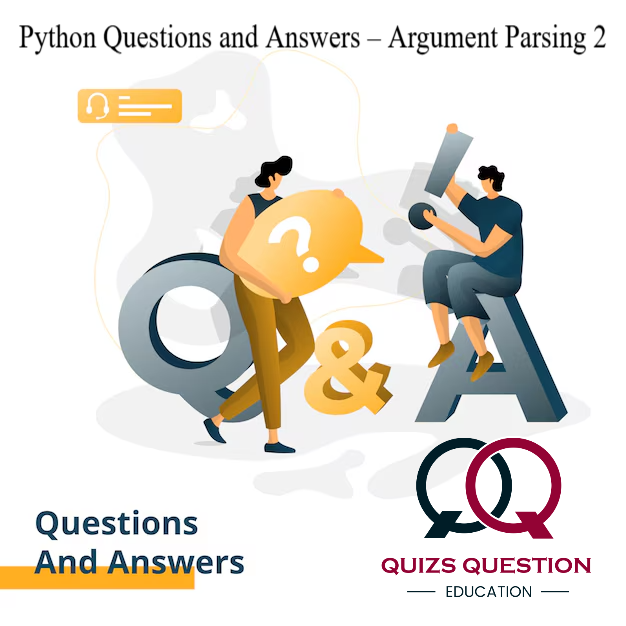Python Multiple Choice Questions & Answers (MCQs) focuses on “Argument Parsing”.
Q 1. What will be the output of the following Python code?
def foo(k):
k = [1]
q = [0]
foo(q)
print(q)
A. [0]
B. [1]
C. [1, 0]
D. [0, 1]
Show Answer
Answer:-A. [0]Explanation
A new list object is created in the function and the reference is lost. This can be checked by comparing the id of k before and after k = [1].
Q 2. How are variable length arguments specified in the function heading?
A. one star followed by a valid identifier
B. one underscore followed by a valid identifier
C. two stars followed by a valid identifier
D. two underscores followed by a valid identifier
Show Answer
Answer:-A. one star followed by a valid identifierExplanation
Refer documentation.
Q 3. Which module in the python standard library parses options received from the command line?
A. getopt
B. os
C. getarg
D. main
Show Answer
Answer:-A. getoptExplanation
getopt parses options received from the command line.
Q 4. What is the type of sys.argv?
A. set
B. list
C. tuple
D. string
Show Answer
Answer:-B. listExplanation
It is a list of elements.
Q 5. What is the value stored in sys.argv[0]?
A. null
B. you cannot access it
C. the program’s name
D. the first argument
Show Answer
Answer:-C. the program’s nameExplanation
Refer documentation.
Q 6. How are default arguments specified in the function heading?
A. identifier followed by an equal to sign and the default value
B. identifier followed by the default value within backticks (“)
C. identifier followed by the default value within square brackets ([])
D. identifier
Show Answer
Answer:-A. identifier followed by an equal to sign and the default valueExplanation
Refer documentation.
Q 7. How are required arguments specified in the function heading?
A. identifier followed by an equal to sign and the default value
B. identifier followed by the default value within backticks (“)
C. identifier followed by the default value within square brackets ([])
D. identifier
Show Answer
Answer:-D.identifierExplanation
Refer documentation.
Q 8. What will be the output of the following Python code?
def foo(x):
x[0] = [‘def’]
x[1] = [‘abc’]
return id(x)
q = [‘abc’, ‘def’]
print(id(q) == foo(q))
A. True
B. False
C. None
D. Error
Show Answer
Answer:-A. TrueExplanation
The same object is modified in the function.
Q 9. Where are the arguments received from the command line stored?
A. sys.argv
B. os.argv
C. argv
D. none of the mentioned
Show Answer
Answer:-A. sys.argvExplanation
Refer documentation.
Q 10. What will be the output of the following Python code?
def foo(i, x=[]):
x.append(x.append(i))
return x
for i in range(3):
y = foo(i)
print(y)
A. [[[0]], [[[0]], [1]], [[[0]], [[[0]], [1]], [2]]]
B. [[0], [[0], 1], [[0], [[0], 1], 2]]
C. [0, None, 1, None, 2, None]
D. [[[0]], [[[0]], [1]], [[[0]], [[[0]], [1]], [2]]]


Leave a Reply